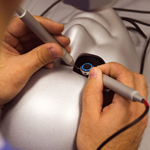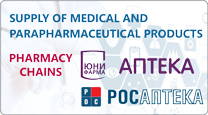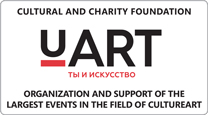Without fear and beyond reproach
Text: Arina Soboleva
Photo:
Sergey Karpov
We all know kids must regularly see their dentist. And there is probably nothing scarier in the world than going to the dentist — that we know, too. We also know that today’s dental treatment is a totally painless procedure. Seriously, this is the 21st century! And still we fear going to a dental clinic, because we have this premonition that even if it’s going to be alright in terms of physical pain, it’s certainly going to hurt our wallet. Be as it may, kids must regularly see their dentist…
|
Tatyana Nefedova, |
“There are always two patients at my office – a child and his mother,” doctor Tatyana Nefedova, the head of the direction of pediatric dentistry in the network of Unident clinics, says. “And I pay attention to both of them, and communicate with each of them in accessible and clear language.
To enable parents to make appropriate decisions, you need to convey to them information about the presence of “dental problems” of their child and the necessity of those or other manipulations. In this case, regardless of complexity and duration of the procedure, it is very important to deserve the child’s confidence, not to scare and not to hurt him.
In the case of preschool and early school age children
We have come to one of the clinics of Unident network,
located in Moscow on Chistiye Prudy, in order to understand what a modern
pediatric dentistry can answer
.
Psychological adaptation

A six year old girl with an unusual name Angel Maria is waiting for her call to enter in front of the office of a pediatric dentist. After her eight teeth were treated under general anesthesia and put special children’s crowns on a month ago, Masha came to the clinic for the first routine examination.
The main concern of the parents who take a child to the dentist’s is the question of how to do it so that he would let the doctor administer the treatment.
“I know that my Masha needs time, she needs to talk to the doctor, to get comfortable, “says Elena, the girl’s mother. “It is not possible in many hospitals. Here some time is set aside for getting acquainted and to create a friendly atmosphere of communication. It helped us, at first we just came for a visit and Tatyana Alekseyevna just mesmerized us.”
In modern dentistry, great attention is paid to psychological adaptation of the child in the clinic. Therefore, the first visit to the doctor should be a trial. Adaptation examination, experts believe, is an important preparatory stage before treatment. The doctor meets a child and gives him an opportunity to examine the situation, equipment, tools.
“We show almost everything that will be involved in the treatment, and try to explain to a child why tools are needed. Only then can we start working. And the younger the patient is, the more attentively the dentist should treat this.”
We have to admit that Masha is really afraid of neither the doctors, nor the equipment, nor even rotary instruments. She suggests a hypothesis about how to control the stomatological unit, sees her way clear to turn on the lamp or lower the chair. A dental office for her is no different from the space in the lobby of the children’s unit, where there are toys and where she has just been drawing on the board.
|
Little patients waiting for the doctor: without fear and beyond reproach |
A sore point
Besides the conditions for psychological adaptation of the child, the most important condition for treatment is painlessness of all the procedures carried out by the doctor.
 “If a child is hurt just for
once, he will not sit down in the chair in the future, of course,” Tatyana
Nefedova says. “And modern technologies play a huge role, enabling us to
perform all the necessary manipulations quickly and without serious discomfort
for the child. This is true even in surgery, where it is possible to carry out
common procedures, such as the discission of bands, frenuloplasty of the tongue
and of the upper and lower lips, bloodlessly and painlessly with the help of
diode lasers. It is very important that the rehabilitation period after the
surgery is much easier and faster.
“If a child is hurt just for
once, he will not sit down in the chair in the future, of course,” Tatyana
Nefedova says. “And modern technologies play a huge role, enabling us to
perform all the necessary manipulations quickly and without serious discomfort
for the child. This is true even in surgery, where it is possible to carry out
common procedures, such as the discission of bands, frenuloplasty of the tongue
and of the upper and lower lips, bloodlessly and painlessly with the help of
diode lasers. It is very important that the rehabilitation period after the
surgery is much easier and faster.
For the treatment of carious lesions in a modern pediatric dentistry there are minimally invasive techniques, such as the ICON, which allows stopping caries at an early stage. After processing the tooth surface with a special composition and special conditioning with a polymerization lamp, the carious process is stabilized and hard tissue defect becomes virtually invisible. The truth is that this technique can be used only at the very early stages of caries. And since carious process is progressing in children much faster than in adults, of course, it is more complicated to snatch the moment.”
Openness to modern methods of treatment
 There are methods of treatment,
which surprise parents to say the least. For example, a doctor’s recommendation
to place a crown on a child’s milk tooth causes bewilderment. This technique
has been widely spread in Russia only recently and has not become habitual yet.
Quite often, the upper part of the milk tooth is destroyed due to the
aggressive caries process, while the roots of the teeth can be saved. In these
cases, steel caps replacing the destroyed part of the teeth are used.
There are methods of treatment,
which surprise parents to say the least. For example, a doctor’s recommendation
to place a crown on a child’s milk tooth causes bewilderment. This technique
has been widely spread in Russia only recently and has not become habitual yet.
Quite often, the upper part of the milk tooth is destroyed due to the
aggressive caries process, while the roots of the teeth can be saved. In these
cases, steel caps replacing the destroyed part of the teeth are used.
“It is necessary to restore the crown portion of the tooth to children to keep the height of the bite and the size of the dental arcade as it should be,” Tatyana Nefedova explains. “This affects articulation, pronunciation of sounds, the quality of chewing food and the development of chewing muscles. Such problems as bone atrophy may appear with a loss of a tooth. Then the child will achieve the age of a mixed bite with dental malalignment or micrognathia.
|
“Should I become a dentist when I grow up?” |
Carefully weighed decisions
“Masha is a special girl, and I say so not because she is my child,” Elena says. “I see that she is a tiffany nature and that is why I try to protect her. For example, I have nephews, they are quite pushy and we have to be tougher with them. And Masha is a sensitive person. Therefore, general anesthesia just a way out for us, I wouldn’t have let treat her eight teeth in turn. She had a lot of holes in her teeth, but it happened so that we cured one tooth and during the following visits she already did not let the doctor do anything, cried and asked to let her go home,” Masha’s mother says.

Despite the fact that the words “child” and “general anesthesia” are difficult to be put together psychologically, it is especially in pediatric dentistry that it is used in many cases. Although, of course, this is not a casual method of treating children. It is applied only in situations where alternatives cannot be used or they cause greater harm to the child.
“Considering the risk and benefit of the treatment of a large number of teeth in a small child, of course, it is wiser in terms of medicine to give preference to general anesthesia,” Tatyana Nefedova says. “For example, if a child has eight teeth with complex cavity, it is necessary to apply local anesthesia eight times with the intervals of three to four days. There is a significant risk of allergies because immune response begins in the body after one or two injections. In addition, there are numerous medical problems in which general anesthesia is exclusively medically necessary for children.”

“I have a medical education, so of course, I know what general anesthesia is,” Elena says. “And this knowledge rather prevented me from making a decision. Even more doubt appears when you start reading about allergies and intolerances on the Internet. I decided that I will not delve in all this and just trust the doctor,” says Elena.
It is hard to say whose role in the treatment process of a child is crucial. Of course, an obvious answer offers itself — it is the role of the doctor. But the doctor is actually chosen by the parents. Thus, the parents? Or a child who decides not to open his mouth in the most critical moment, when he is asked to? Decisions are taken by all the parties and it is important that all of them are well grounded.
Today, children’s dentistry, in case, of course, we are talking about

“We should understand that even if the child has already happened to be in the situation of stress associated with the treatment of teeth and he already avoids dentists like the plague, in most cases, you can handle it. And here preventive visits to the doctor can help most of all. Besides the fact that it helps to identify a carious process at an early stage, it also leads to confidence between the parents and the doctor, the child and the doctor, the parent and the child.
The child understands that if he does something right, the things that his mom and his doctor say, the number of his visits to the doctor is declining, and they are endured much easier, “ Tatyana Nefedova says . “As a result, after some time the visits to the doctor will become a part of the routine, like the visits to the hairdresser’s. And they will not cause any protest, or aggression, or sense of fear and certainly any panic.
Back













